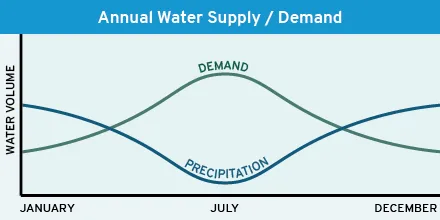Do your part to use water wisely this summer. It's just the right thing to do.
Unlike many parts of Oregon and the Western U.S, the Portland metro region is fortunate to have many water sources that will be able to meet the area’s water demands this summer. You can be a good steward of our region's water by learning about how your water source responds to high water use and drought conditions below and using these tips to use water efficiently at home and outside this summer.
Working together is what we do.
The Consortium’s members have worked together for 25 years to ensure that the region's water needs can be met in the face of drought or other water shortages. Water providers track the region's changing water supplies throughout the year, especially during the summer months, and are ready to work together to proactively address any issues that arise.
Find out more about your water and how it responds to drought conditions
Water sources, supply, and treatment methods vary throughout the region and the state. The Portland, OR metro area has five main water sources and they all respond differently to high water use and drought.
The Bull Run Watershed is primarily a rain-fed system, so there is less water entering the storage reservoirs in the summer when rainfall decreases. The 9.9 billion gallons of stored water supply in the reservoirs typically meets Portland and its wholesalers’ needs through the summer. The Columbia South Shore Well Field can also be used to supplement surface water or replace the Bull Run supply entirely due to turbidity or other issues. The Portland system is resilient to drought and other water shortage events due to its access to two water sources.
The Trask / Tualatin River system is highly managed by its users and regulators to ensure water supplies are sufficient to meet peak summer demand. Barney Reservoir and Scoggins Reservoir (Hagg Lake) allow the Joint Water Commission to store water from the winter for later release in the summer. Some providers also have access to other sources, such as aquifer storage and recovery wells, the Bull Run Watershed, and the Columbia South Shore Well Field.
The Clackamas River is carefully managed to meet all water needs. The community works together to conserve water to ensure there is enough water for people and fish. The river system has no drinking water storage facilities, such as dams, so municipal water providers and other users rely on natural stream flows or “run of river” to meet water needs all times of year, including the summer when stream flows go down. Fortunately, some water in the watershed is stored as snow which melts over time, keeping water cool for fish and providing a gradual release of water into the river. The Clackamas River is also fed by rain and groundwater.
To help protect migrating salmon and steelhead, each year between mid-August and early October the Clackamas River Water Providers, whose members use the Clackamas River as a drinking water source, ask their customers to participate in the annual “Fish On the Run, Irrigation Done!” campaign. This education campaign focuses on reducing or shutting- off outdoor watering by the beginning of September to keep more water in the river for the fall fish migration.
The Willamette River is a reliable year-round water supply. The system is highly managed by a number of dams operated by the US Army Corps of Engineers. This enables sufficient water supplies to meet peak summer demand and other important flow targets for environmental, agricultural, and drinking water needs.
To provide additional reliability, the City of Wilsonville's former water supply (a system of eight local wells) is available for use during dry periods or other emergencies. The Tualatin Valley Water District and the Cities of Hillsboro and Beaverton are working on developing the Willamette Water Supply System which will come online in 2026. This new system will enable project partners to manage their various supply sources to respond to drought or other supply interruptions as well as recover more quickly from a large natural disaster.
Groundwater is less vulnerable to short-term water shortages and extreme weather events than surface water sources, but it is still vulnerable to drought and overuse. Water providers that rely on groundwater depend on rain, stream flows, and snowmelt to replenish aquifers. Depending on the geology, this recharge can take weeks, years, decades, or longer to occur. Groundwater levels are regularly monitored to track aquifer conditions.
Aquifer Storage and Recovery (ASR) is a resource that some water providers use to supplement their water supply during drier, warmer months when customer’s water demand is high. It involves putting treated drinking water into aquifers when water is plentiful in the winter and then pumping it out in the summer.
Get more information on drought in Oregon
- The Oregon Water Resource Department provides a weekly water conditions report which you can sign up to receive via email.
- The U.S. Drought Monitor focuses on broad, regional factors including soil conditions and not individual water supplies. The dry early spring weather conditions in certain parts of Oregon followed by the record-setting heat wave contributed to this designation.

